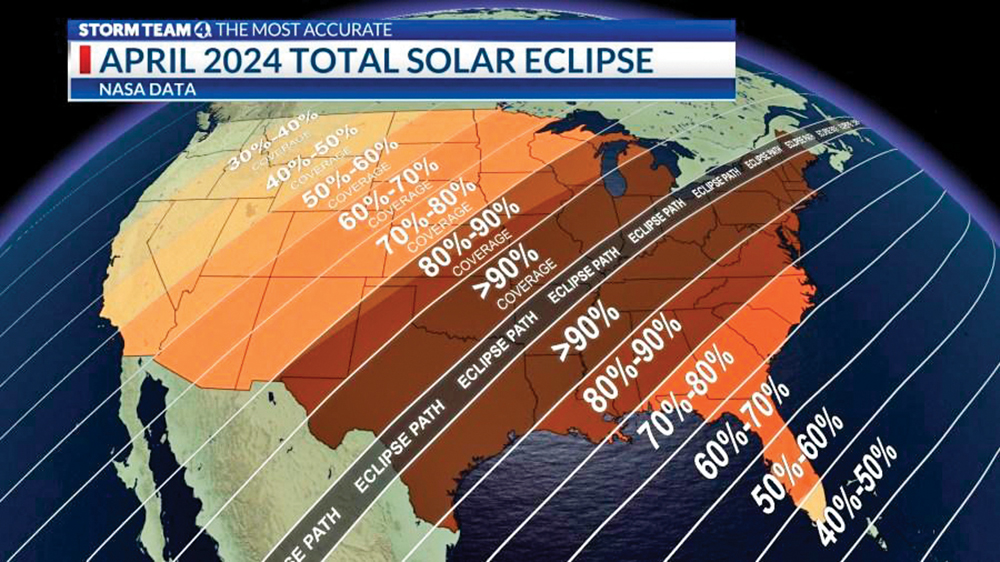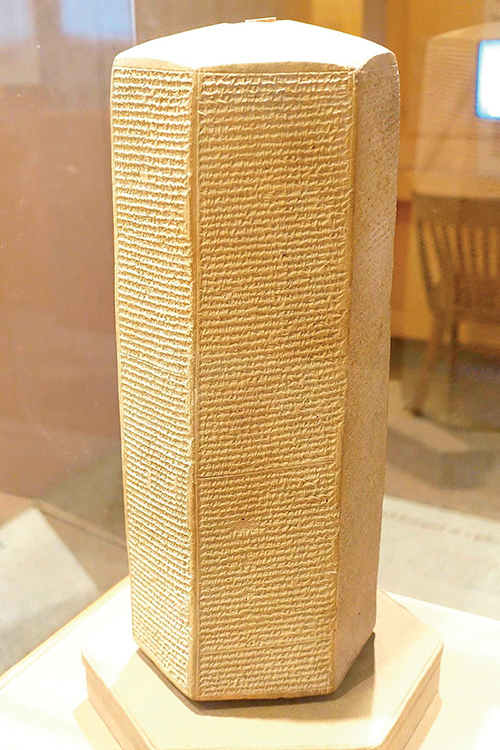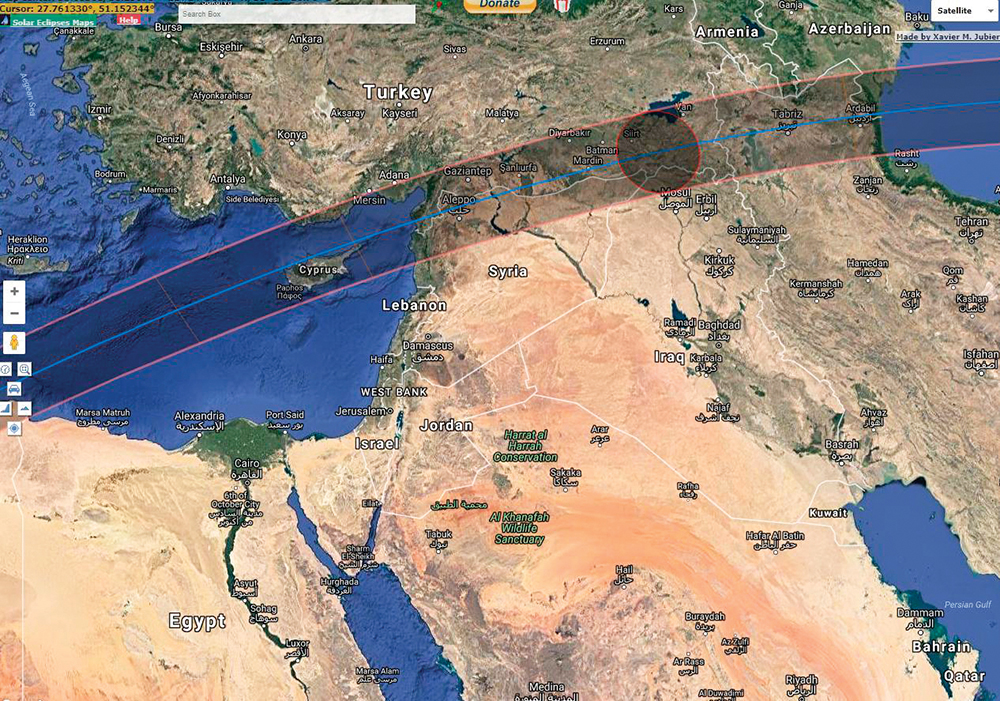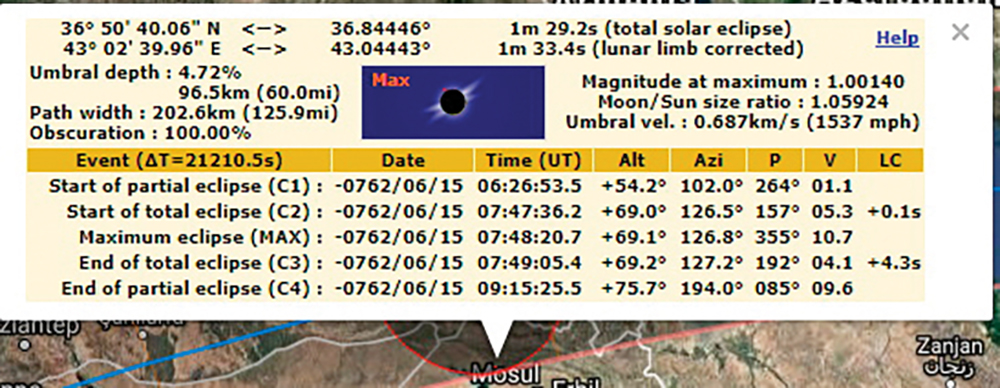
And on that day—declares my Lord God—I will make the sun set at noon, I will darken the earth on a sunny day.
Amos 8:9
“I have reflected, Sir King. For a lesson, I will let this darkness proceed, and spread night in the world; but whether I blot out the sun for good, or restore it, shall rest with you.”
A Connecticut Yankee
In King Arthur’s Court
This past week, we experienced both a solar eclipse and a minor earthquake. While these events are a marvel of science, for the ancients who had no way to predict or explain them, they were nothing short of miraculous or magical depending on one’s point of view.
A total solar eclipse happens “when the New Moon comes between the sun and earth and casts the darkest part of its shadow, the umbra, on earth. A full solar eclipse, known as totality, is almost as dark as night.” Total solar eclipses are fairly common throughout the world, occurring once every 18 months, but one happening in a particular place is rare, maybe once every four centuries. This is why we highly anticipated the recent total solar eclipse which took place this past Monday, April 8, 2024. The entire continent experienced a partial eclipse with the line of the total eclipse some 70 miles wide passing through the United States from the northeast to the southwest and the NY/NJ area experiencing a deep partial eclipse at 92%. You can see the eclipse map below.

The prophet Amos has a number of references seeming to describe a solar eclipse as does his contemporary Isaiah. Besides the one quoted in the beginning of this article, see Amos 4:13, Amos 5:8, Amos 8:9 and Isaiah 13:9-10. It also seems to be a part of the prophecy of the apocalypse in both Yoel 3:4 and Zechariah 14:6-7. Each of these references can be interpreted metaphorically, but taken together, they appear to describe an actual event. Only one total eclipse occurred over the Middle East during the time period of Amos and Isaiah, the first half of the 8th Century BCE. This eclipse which happened on June 15, 762 BCE is known as the Assyrian Eclipse since it is recorded in the Assyrian Eponym List, an ancient Assyrian timeline of important events.
[762/763] During the eponymy of Bur-Saggile, governor of Guzana, revolt in Libbi-ali; in Simanu eclipse of the sun [15 June 762].
This eclipse reached totality over the Assyrian empire including its capital, Nineveh which is located near the modern city of Mosul. This eclipse has been thoroughly documented in astronomical records with a map of the eclipse including the precise time and date that it reached totality over Nineveh which you can see.
While Nineveh experienced a total eclipse, the kingdoms of Israel and Judah saw a partial eclipse with a magnitude of over 90%, still an impressive event. This is likely the eclipse mentioned by Amos and Isaiah. (It is also the answer to a great trivia question: What is the only event mentioned in Tanach whose time of occurrence can be verified scientifically to the second?)
But what purpose does it serve for a prophet like Amos or Isaiah to reference the solar eclipse?
To answer this, we must explore the historical background of Amos’s prophetic career. The prophet Amos begins with a historical marker, referencing an event even more traumatic and certainly more damaging than an eclipse, the great earthquake.
(1) The words of Amos, a sheep breeder from Tekoa, who prophesied concerning Israel in the reigns of Kings Uzziah of Judah and Jeroboam son of Joash of Israel, two years before the earthquake.
Amos 1:1
This earthquake is mentioned even more often in Tanach than the eclipse, with references in Amos 3:14-15, Amos 4:10-13, Isaiah 2:19-21 and Zechariah 14:5, and it provides the setting for Isaiah’s inaugural prophecy in Isaiah 6:1-4. Archeological evidence of the earthquake has been uncovered by Yigal Yadin at Hazor. Evidence of this earthquake has also been uncovered at five other sites spread throughout Israel, Deir ‘Alla, Gezer, Lachish, Tell Judeideh and ‘En Haseva, and the magnitude of this earthquake has been estimated at between 7.8 and 8.2 on the Richter scale.

To the prophets, events like earthquakes or eclipses were not just natural phenomena but portents of even worse calamities to come if the people do not take heed and repent.
The earthquake for example is viewed as a direct result of the arrogance of King Uzziah. The Tanach describes in Chronicles II 26:16-21 how at the height of his reign, Uzziah chose to burn incense in the Holy of Holies in the Temple, something only the High Priest was allowed to do. As a result, Uzziah was stricken by leprosy and had to live the rest of his days in solitude as his son Jotham took over as prince regent. Rashi on Amos 1:1 comments that Uzziah did not just suffer a personal punishment for his arrogant act, but at the moment Uzziah brought the incense into the Holy of Holies, the entire country was stricken by the great earthquake.
Rashi on Isaiah 7:8 based on Seder Olam posits that Amos began his prophetic career 65 years before the exile of the 10 tribes which historians date to 722 BCE. Since Amos 1:1 asserts that his inaugural prophecy took place two years prior to the earthquake, this would date the earthquake to 785 BCE. Many historians date Uzziah’s leprosy which caused the earthquake some 20 years later, approximately 762 BCE.
The first half of the 8th Century BCE was a time of peace and prosperity for the kingdoms of Israel and Judah. King Jeroboam II expanded Israel to its largest borders since the time of David and Solomon and Israel was at its most prosperous. The Kingdom of Judah under King Uzziah experienced similar prosperity. The prophets saw beyond the affluence to the many people still suffering on the fringes of society.
The challenge of prophets like Amos was to help the people realize that this period of peace could be short-lived. Israel and Judah needed to utilize their prosperity to help those who were not as well off as them or else they would be punished. The primary tool they had to convince the people was their use of language. Some of the most beautiful prophecies about social justice, including much of the source material for Martin Luther King’s famous “I Have a Dream” speech, come from the prophets of this time, Amos and Isaiah.
The prophets had another tool at their disposal. They could make predictions of future events. When these events came true exactly as described they would add conviction to their further warnings. This is where the earthquake and eclipse played a key role. Amos began his career two years prior to the great earthquake. He spent much of his beginning prophecies warning the people about this event. When the earthquake occurred, it gave credence to Amos’ words of rebuke. But the people still did not listen and change their ways.
So Amos made another prediction, this one of an event that would terrify the people, but unlike the earthquake, would have no lasting negative effect on them. He predicted that the sun would grow dark in the middle of the day, what we know as a total solar eclipse.
According to historians who date the earthquake as occurring in approximately 762 BCE, Amos’ prophecies would be even more terrifying for the people. Amos’ twin predictions, the earthquake which caused much physical damage in Israel and the total solar eclipse in which the sun apparently blotted out for a short time, would have happened within a year of each other.
The total solar eclipse occurred on June 15, 762 BCE, 40 years prior to the predicted exile of the 10 tribes. Israel still had 40 years to repent prior to the impending ultimate doom. 40 years is a significant number in Judaism starting with the Israelites 40 year sojourn in the desert. A few generations after Amos and Isaiah, Jeremiah would similarly begin his prophetic career 40 years prior to the destruction of the First Temple with predictions of doom and gloom unless the people repented.
The solar eclipse came exactly as predicted but the Kingdom of Israel still did not change their ways. Ultimately, they were exiled by the Assyrians, the epicenter of the total solar eclipse, in 722 BCE. It was the kingdom of Judah under King Hezekiah and the prophet Isaiah who, seeing what happened to their Israelite brothers and sisters to the north, took heed to the warnings of Amos and Isaiah. They repented from their ways and were miraculously saved from Assyrian conquest, an event alluded to in Sennacherib’s Annals where Sennacherib, the King of Assyria, lists all the cities he conquered in the kingdom of Israel and most of the cities of Judah. He boasts, “As for Hezekiah, I trapped him like a bird in a cage in his royal city of Jerusalem.” But Sennacherib never writes that he conquered Jerusalem since he did not. The majority of his soldiers died during the siege of Jerusalem in a mysterious plague and Sennacherib was forced to withdraw to Assyria.

So what message can we glean from these twin events of an eclipse and earthquake this past week? Unfortunately, we no longer have great prophets like Amos and Isaiah anymore, and after the destruction of the Temple, Rabbi Yocḥanan in Baba Batra 12b asserts that prophecy was taken from the Prophets and given to fools and children. However, this does not mean we should not try to find some personal meaning from these events. Clearly God who controls nature and equally controls history is trying to shake us up.
Perhaps one message we can see is the need for Jewish unity in these trying times. In my yeshiva, I have had the privilege these past few weeks to hear from a number of survivors from the Oct. 7 attacks and brave Israeli soldiers describing their recent operations to defend the Jewish people. These Jewish heroes who have traveled from Israel to the States, many for the first time, have marveled about the support of Am Yisrael throughout the diaspora. Many had not even realized that there was a vibrant Jewish people outside our homeland. At the same time, the gatherings of Jews from all walks of life and all denominations: Orthodox, Conservative and Reform (terms I hate since we are really just all Jews), to support our local shuls and Jewish organizations in Teaneck which have been targets of anti-Jewish demonstrations, has been a source of inspiration. I have experience throughout my life rallying in Washington, DC and the UN, but rallies in Teaneck were never on my bucket list. Jewish unity regardless of religious background or affiliation will hopefully continue. Our current exile began, our rabbis teach us, due to senseless hate, and God willing we will experience peace due to our continued showing of unbridled love and Jewish support.
Rabbi Tzvi Pittinsky is the director of educational technology at Yeshivat Frisch. He can be reached at [email protected].












